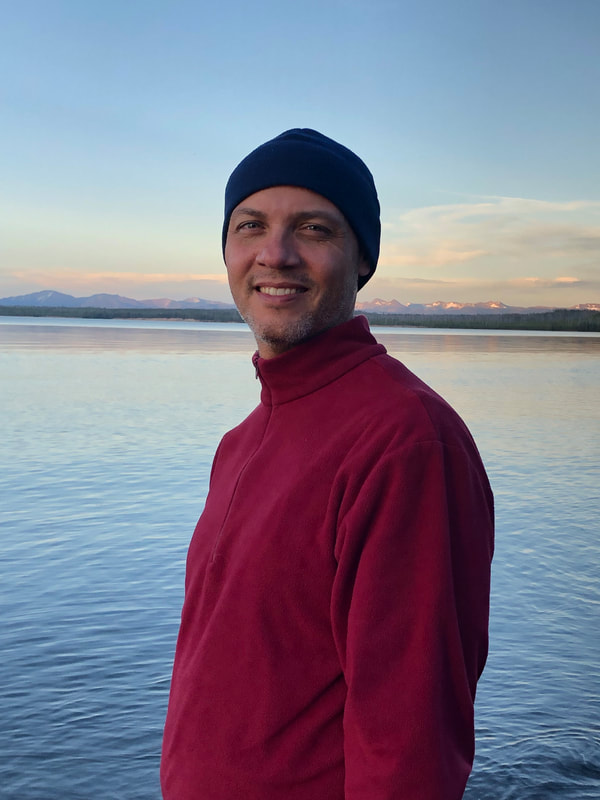In a general sense, I consider ecohydrology the study of bi-directional interactions between hydrological and ecological processes. Much of ecohydrology could be organized under high-level questions like: how do water status and flow influence ecosystem structure and function, and how do ecosystem structure and function affect water status and flow? The boundaries of ecohydrology are fluid (no pun intended) and ever-expanding, which is something I welcome.
What are your undergraduate and graduate degrees in?
I have a BS in Geology from Duke University and graduate degrees in Environmental Sciences from the University of Virginia.
How did you arrive at working in/thinking about ecohydrology?
I was exposed to one particular vein of ecohydrology early in graduate school. Paolo D’Odorico, my MS committee member and eventual PhD co-advisor, worked with Ignacio Rodriguez-Iturbe on interactions between soil moisture and vegetation in one-dimensional water balances. Their conceptual framework strongly influenced my early research. I paired some of their concepts with flux tower methods taught by other mentors, John Albertson and Howie Epstein, to study impacts of plant water stress on ecosystem carbon and water cycles.
Later on, my PhD co-advisors, D’Odorico and Epstein helped me extend ideas about water stress to questions about streamflow, evapotranspiration, and biogeochemical cycling across entire watersheds. At this scale, water is still a vital resource for ecosystem functions, but it also carries information about finer-scale ecohydrological processes from one part of the landscape to another. As an early-career scientist, collaborations with watershed hydrologists like Brian McGlynn, Lucy Marshall, and their students helped me think about ecohydrological processes as part of amazingly complex catchment systems. For the past decade or so, my students and postdocs have taken this basic view of ecohydrology and enriched it with their own creativity and insight.
What do you see as an important emerging area of ecohydrology?
Although I feel like I work in one small corner of ecohydrology, I can see important conceptual advances on the threshold, if not already coming through the doorway of our discipline. Conceptually, ecohydrology still has a lot to learn about water’s dual role as a limiting ecological resource and as a carrier of signals across landscapes. Because we don’t have universal definitions for phenomena like water stress or for what it means for water to “carry a signal,” there are emerging opportunities to draw connections between great work happening now throughout the ecohydrology community.
I think that many in our community recognize the fluidity of ecohydrology’s scope and boundaries. For that reason, I think it’s important to acknowledge that an emerging area of ecohydrology is its ability to look outward and connect with other fields, while still carrying out robust research at the core of our field. For my part, I’ve begun connecting ecohydrology with broader societal questions about public policy, environmental justice, and indigenous knowledge systems. I am a citizen of the Lumbee Tribe, a group that is indigenous to the southeastern part of the present-day US state of North Carolina. Our territory encompasses blackwater streams and forested wetlands that provide great examples of bi-directional interactions between hydrological and ecological processes. However, when I look at these landscapes as Lumbee person I also see deep historical and cultural relationships between people, land, and water that help define us as indigenous people. My training in ecohydrology gave me one particular set of tools for thinking about relationships between land and water, and I consider those tools incomplete. Lumbee people, like many indigenous peoples, I have much richer ways of understanding relationships with land and water.
I think indigenous ways of knowing are important to share with others, because they help us see the bigger picture of water and life. Indigenous perspectives can be important to consider when we are building socio-hydrological models, developing public policies, planning fossil fuel pipelines, or engaging in a host of other activities that affect relationships between ecosystems, water, and people. In recent years, ecohydrology has been grappling with ways to incorporate human dimensions into modeling and quantitative analysis. This is important work that can benefit from indigenous perspectives.
Do you have a favorite ecohydrology paper? Describe/explain.
I don’t have a favorite ecohydrology paper, although many papers have influenced my thinking about ecohydrology through the years. When I think about representation of indigenous perspectives in ecohydrology (or other fields), one influential paper is “A global assessment of Indigenous community engagement in climate research” by Dominique David-Chavez and Michael Gavin, published last year in Environmental Research Letters. Focusing on published climate studies, they find most published research to be extractive rather than participatory or community-based. The paper is a call to respectful, conscientious, and responsible research partnerships with indigenous peoples.
What do you do for fun (apart from ecohydrology)?
I have a lifelong love of paddlesports that has evolved through various stages of my life. I am currently into canoeing and paddle boarding on blackwater streams in eastern North Carolina, sometimes alone and sometimes with family or friends. As a Lumbee person, I descend from Indigenous peoples who have paddled canoes on these exact streams since time immemorial. Also, one of my postdocs taught me to brew kombucha earlier this year. I enjoy sharing kombucha with family and friends.

 RSS Feed
RSS Feed